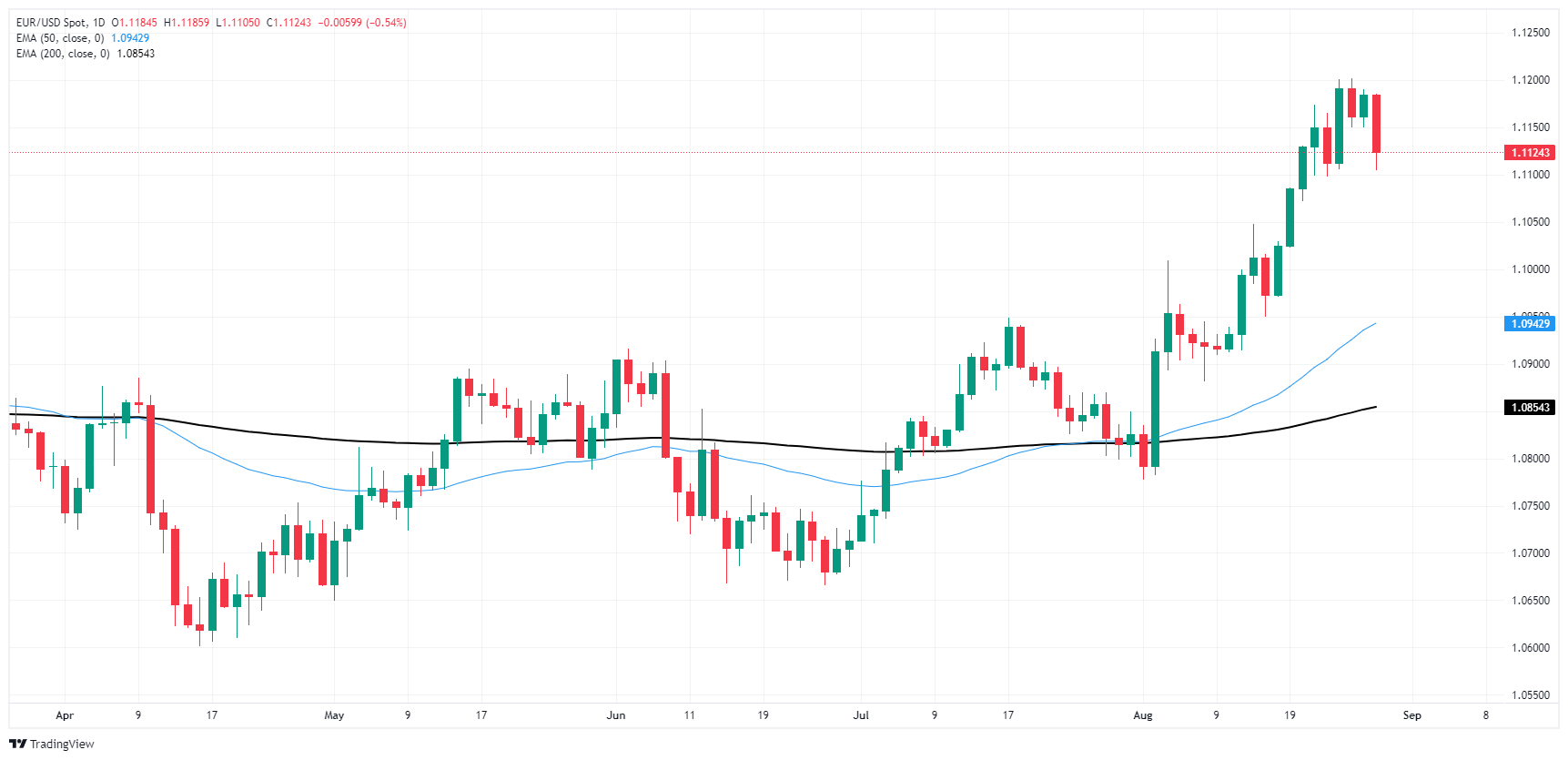- Analytics
- News and Tools
- Market News
- EUR/USD pares recent gains, poised for further downside
EUR/USD pares recent gains, poised for further downside
- EUR/USD slipped back below 1.1150 as bidders struggle to maintain balance.
- A breakdown in bullish market sentiment is giving the Greenback room to breathe.
- EU and US inflation prints due at the end of the week to dominate investor attention.
EUR/USD trimmed recent gains on Wednesday, stepping lower after clipping fresh highs for the year as broad-market anticipation of Federal Reserve (Fed) rate cuts in September keeps broad-market risk appetite pinned to the ceiling.
There is little of note on the economic calendar for the middle range of the trading week, but Thursday will bring an update on US Gross Domestic Product (GDP) figures, which will be closely watched. However, little movement is expected as markets have broadly priced in Q2 annualized GDP growth to hold steady near 2.8%.
Friday’s data docket shows promise for markets slipping into a boredom trance, with a fresh print of pan-EU Harmonized Index of Consumer Prices (HICP) inflation due early in the European market session. Core EU HICP inflation is expected to continue trimming lower across the board, forecast to print at 2.8% YoY in August compared to the previous print of 2.9%.
US Personal Consumption Expenditure Price Index (PCE) inflation due on Friday remains the week’s key print, and investors are shuffling their feet while they wait for signs that inflation will continue to ease, or at least not rise, fast enough that the Federal Reserve (Fed) will be kept on rails to deliver a hotly-anticipated rate cut on September 18.
EUR/USD price forecast
EUR/USD slipped back below the 1.1150 level on Wednesday as bidders struggle to keep the Fiber moving north. The pair is still testing the waters well north of the 200-day Exponential Moving Average (EMA) at 1.0850, but a sustained slide will quickly see price action tumble back to the 50-day EMA near 1.0940.
EUR/USD daily chart
Euro FAQs
The Euro is the currency for the 20 European Union countries that belong to the Eurozone. It is the second most heavily traded currency in the world behind the US Dollar. In 2022, it accounted for 31% of all foreign exchange transactions, with an average daily turnover of over $2.2 trillion a day. EUR/USD is the most heavily traded currency pair in the world, accounting for an estimated 30% off all transactions, followed by EUR/JPY (4%), EUR/GBP (3%) and EUR/AUD (2%).
The European Central Bank (ECB) in Frankfurt, Germany, is the reserve bank for the Eurozone. The ECB sets interest rates and manages monetary policy. The ECB’s primary mandate is to maintain price stability, which means either controlling inflation or stimulating growth. Its primary tool is the raising or lowering of interest rates. Relatively high interest rates – or the expectation of higher rates – will usually benefit the Euro and vice versa. The ECB Governing Council makes monetary policy decisions at meetings held eight times a year. Decisions are made by heads of the Eurozone national banks and six permanent members, including the President of the ECB, Christine Lagarde.
Eurozone inflation data, measured by the Harmonized Index of Consumer Prices (HICP), is an important econometric for the Euro. If inflation rises more than expected, especially if above the ECB’s 2% target, it obliges the ECB to raise interest rates to bring it back under control. Relatively high interest rates compared to its counterparts will usually benefit the Euro, as it makes the region more attractive as a place for global investors to park their money.
Data releases gauge the health of the economy and can impact on the Euro. Indicators such as GDP, Manufacturing and Services PMIs, employment, and consumer sentiment surveys can all influence the direction of the single currency. A strong economy is good for the Euro. Not only does it attract more foreign investment but it may encourage the ECB to put up interest rates, which will directly strengthen the Euro. Otherwise, if economic data is weak, the Euro is likely to fall. Economic data for the four largest economies in the euro area (Germany, France, Italy and Spain) are especially significant, as they account for 75% of the Eurozone’s economy.
Another significant data release for the Euro is the Trade Balance. This indicator measures the difference between what a country earns from its exports and what it spends on imports over a given period. If a country produces highly sought after exports then its currency will gain in value purely from the extra demand created from foreign buyers seeking to purchase these goods. Therefore, a positive net Trade Balance strengthens a currency and vice versa for a negative balance.
© 2000-2025. All rights reserved.
This site is managed by Teletrade D.J. LLC 2351 LLC 2022 (Euro House, Richmond Hill Road, Kingstown, VC0100, St. Vincent and the Grenadines).
The information on this website is for informational purposes only and does not constitute any investment advice.
The company does not serve or provide services to customers who are residents of the US, Canada, Iran, The Democratic People's Republic of Korea, Yemen and FATF blacklisted countries.
Making transactions on financial markets with marginal financial instruments opens up wide possibilities and allows investors who are willing to take risks to earn high profits, carrying a potentially high risk of losses at the same time. Therefore you should responsibly approach the issue of choosing the appropriate investment strategy, taking the available resources into account, before starting trading.
Use of the information: full or partial use of materials from this website must always be referenced to TeleTrade as the source of information. Use of the materials on the Internet must be accompanied by a hyperlink to teletrade.org. Automatic import of materials and information from this website is prohibited.
Please contact our PR department if you have any questions or need assistance at pr@teletrade.global.















